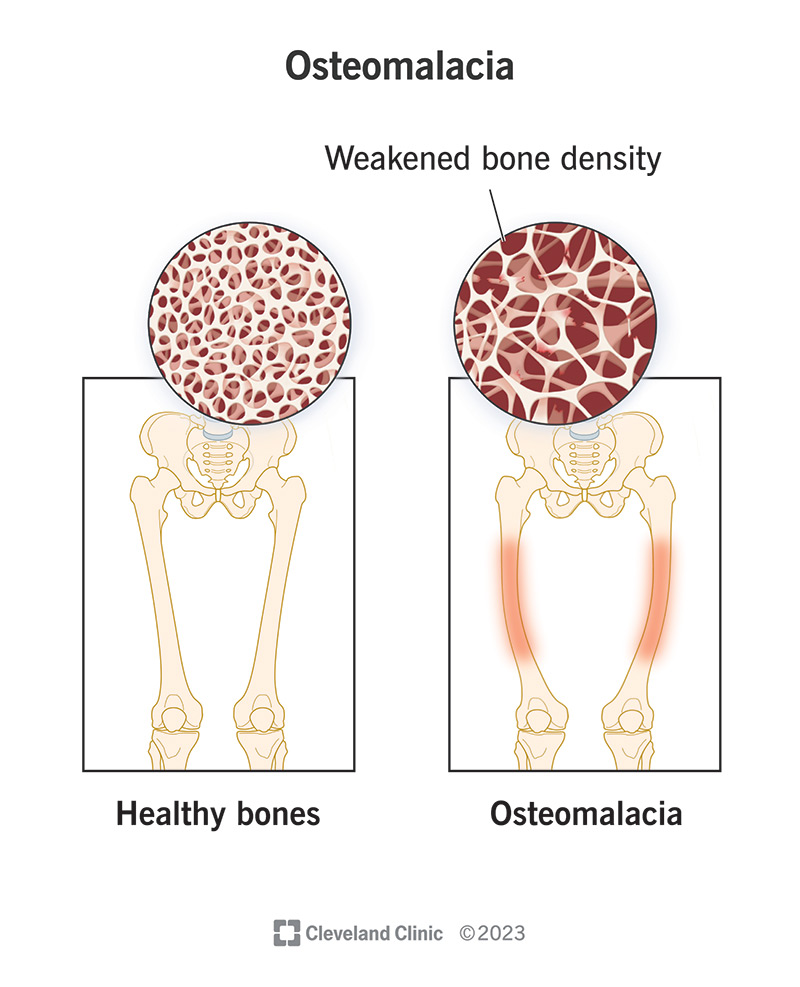Osteomalacia means “soft bones.” A vitamin D deficiency most often leads to this condition. It causes your bones to soften and weaken. In addition to bone pain, you may notice muscle weakness and stiffness. Treatment for osteomalacia usually includes the use of supplements.
Advertisement
Cleveland Clinic is a non-profit academic medical center. Advertising on our site helps support our mission. We do not endorse non-Cleveland Clinic products or services. Policy

Osteomalacia is a condition in which your bones soften and weaken, causing them to break more easily.
Advertisement
Cleveland Clinic is a non-profit academic medical center. Advertising on our site helps support our mission. We do not endorse non-Cleveland Clinic products or services. Policy
It most often affects adults due to a lack of vitamin D. Your body needs vitamin D to absorb calcium and phosphorous. These minerals help your bones maintain their strength and hardness. Without enough vitamin D, your bones don’t mineralize as they usually would. This leads to bone fragility.
In children, inadequate concentrations of vitamin D may cause a similar condition called rickets.
You may not notice osteomalacia at first. But over time, it can cause bone pain, usually in the lower half of your body. Eventually, you may feel pain all over your body. Simple movements may hurt. Know that you don’t have to live with this pain. Reach out to a healthcare provider. They can help find the cause and offer treatment options.
The main symptom of osteomalacia is bone pain. It most commonly affects your hips, pelvis and legs.
Other osteomalacia symptoms may include:
Osteomalacia develops most commonly due to a vitamin D deficiency. This is often from not getting enough sunlight. But it may also be from not getting enough vitamin D from the foods you eat. Vitamin D is essential for calcium absorption and for maintaining bone health.
Advertisement
Other osteomalacia causes may include:
When you’re in sunlight, your skin naturally produces vitamin D. Your skin may not produce enough vitamin D if you:
You may not be getting enough vitamin D from the foods you eat if you:
Other people who have a higher risk of osteomalacia include those who:
Your healthcare provider will do a physical examination and ask about your family and medical history. They’ll also ask questions about your nutrition and activity level.
Your provider will recommend blood tests to check your levels of vitamin D, calcium and phosphorous. The most significant sign of osteomalacia is low levels of vitamin D. But low calcium or phosphorous levels may also point to osteomalacia.
To confirm a diagnosis, your provider may also check your levels of:
Other tests may include:
Osteomalacia treatment includes the use of vitamin D, calcium and/or phosphorus supplements. Your healthcare provider will tell you how much of each of these you need to take. If you have malabsorption issues or recently had bariatric surgery, you may need to take larger doses of vitamin D and calcium.
While supplements should help treat osteomalacia, your symptoms may take several months to improve. Depending on the severity of osteomalacia, you may need to continue taking vitamin D for a long time. If you stop taking it, osteomalacia may return.
People with conditions like liver or kidney failure will need additional treatment and support. Your provider will want to monitor your blood levels regularly. You may need a special form of vitamin D.
Other treatments to relieve or correct osteomalacia symptoms may include:
Advertisement
With early diagnosis and treatment (dietary supplements), most people will start to recover from osteomalacia within a few weeks. But it can still take up to six months for your bones to heal and strengthen again.
Yes, you can usually prevent osteomalacia by:
Depending on where you live and the time of year, you may be able to get enough vitamin D from sunlight alone. People with lighter skin typically need to expose themselves to 10 to 15 minutes of sunshine two to three times per week. People with darker skin usually need more time in the sun. This must be direct sunlight — not through windows or clothing.
Be careful not to spend too much time in the sun without sunscreen. Too much sun exposure can increase your risk for skin cancer. Ask your healthcare provider about how much time you should spend in the sun.
You won’t be able to get all the vitamin D you need through food alone, but it can help. Some foods naturally contain vitamin D. These include:
Advertisement
Other foods are fortified with vitamin D. Talk to your healthcare provider about which sources are best for you. As with anything, you have to weigh the pros and cons of various foods.
If you’re still not getting enough vitamin D through sunlight and food, your provider may recommend a supplement.
As we age, taking care of our bones becomes even more important. To help maintain your bone health:
If you have bone pain or any of the other osteomalacia symptoms, reach out to a healthcare provider. They can test your blood levels and determine if this condition is affecting you.
It may be helpful to ask the following questions:
Advertisement
If you’ve been experiencing bone pain, especially in the lower part of your body, you may have osteomalacia. You can prevent this condition by making sure you get enough vitamin D, whether through sunlight or from the foods you eat. If your symptoms persist, talk to a healthcare provider. They can determine if a vitamin D deficiency is causing your bone pain. And they can help you get on your way to healthier bones.
You might have brittle bones, but an osteoporosis diagnosis doesn’t mean you can’t keep having fun in life. Cleveland Clinic is here to help.

Last reviewed on 02/19/2025.
Learn more about the Health Library and our editorial process.